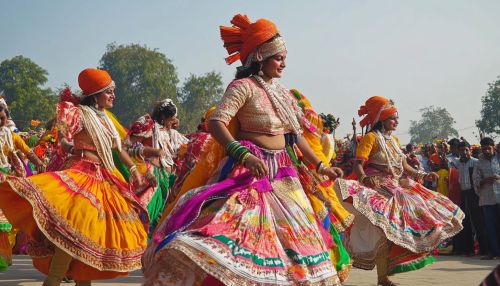Maithili: Difference between revisions
(Created page with "== Introduction == Maithili is an Indo-Aryan language spoken in the Mithila region of India and Nepal. It is one of the 22 scheduled languages of India and is recognized as a regional language in Nepal. The language is named after the ancient kingdom of Mithila, which was located in the northern part of present-day Bihar and the eastern Terai region of Nepal. Maithili has a rich literary tradition and is known for its classical literature, folk songs, and cultural herita...") |
No edit summary |
||
| Line 28: | Line 28: | ||
* [[Tirhuta script]] | * [[Tirhuta script]] | ||
[[Image:Detail-98057.jpg|thumb|center|Traditional Maithili cultural festival with people in traditional attire, performing folk dances and songs.|class=only_on_mobile]] | |||
[[Image:Detail-98058.jpg|thumb|center|Traditional Maithili cultural festival with people in traditional attire, performing folk dances and songs.|class=only_on_desktop]] | |||
== References == | == References == | ||
Latest revision as of 21:17, 21 September 2024
Introduction
Maithili is an Indo-Aryan language spoken in the Mithila region of India and Nepal. It is one of the 22 scheduled languages of India and is recognized as a regional language in Nepal. The language is named after the ancient kingdom of Mithila, which was located in the northern part of present-day Bihar and the eastern Terai region of Nepal. Maithili has a rich literary tradition and is known for its classical literature, folk songs, and cultural heritage.
Historical Background
Maithili has a long and storied history that dates back to ancient times. The earliest references to the language can be found in the Vedic texts, where it is mentioned as the language of the Mithila region. The language evolved over centuries, influenced by various dynasties and cultures that ruled the region. During the medieval period, Maithili literature flourished under the patronage of the Karnata and Oiniwar dynasties. The language reached its zenith during the reign of the Maithil Brahmins, who were known for their scholarly pursuits and contributions to literature.
Linguistic Features
Maithili is characterized by its distinct phonological, morphological, and syntactic features. The language has a rich vowel system, including short and long vowels, nasalized vowels, and diphthongs. Consonant clusters are common, and the language exhibits a range of retroflex and dental sounds. Morphologically, Maithili is an inflectional language with a complex system of verb conjugation and noun declension. The syntax of Maithili follows a Subject-Object-Verb (SOV) word order, typical of many Indo-Aryan languages.
Script and Writing System
Maithili was traditionally written in the Tirhuta script, which is closely related to the Devanagari script. The Tirhuta script has been in use since ancient times and is known for its distinct calligraphic style. However, in modern times, Devanagari has become the predominant script for writing Maithili, especially in India. Efforts are being made to revive the Tirhuta script, and it is still used by some scholars and in certain cultural contexts.
Literature and Folklore
Maithili boasts a rich literary tradition that spans several centuries. The earliest known work in Maithili is the "Varna Ratnakara" by Jyotirishwar Thakur, written in the 14th century. The language saw a golden age during the 15th and 16th centuries with the works of Vidyapati, a renowned poet whose compositions are considered masterpieces of Maithili literature. Vidyapati's poetry, known for its lyrical beauty and devotional themes, has had a lasting impact on the language and culture of the region.
Folk literature in Maithili includes a wide range of genres such as folk songs, ballads, and oral narratives. The "Sama Chakeva" festival, celebrated in the Mithila region, is known for its folk songs that depict the love and devotion between siblings. These songs are an integral part of the cultural heritage of Maithili-speaking communities.
Cultural Significance
Maithili is not just a language but a vital part of the cultural identity of the Mithila region. The language is deeply intertwined with the customs, traditions, and rituals of the people. Festivals such as Chhath, Durga Puja, and Holi are celebrated with great fervor, and Maithili songs and dances are an essential part of these celebrations. The "Madhubani" style of painting, which originated in the Mithila region, is another significant cultural expression associated with the Maithili language.
Modern Developments
In recent years, there has been a renewed interest in promoting and preserving the Maithili language. Various organizations and cultural groups are working towards the revival of the Tirhuta script and the promotion of Maithili literature and arts. The language is also being taught in schools and universities, and efforts are being made to include it in the digital domain through the creation of Maithili websites, blogs, and social media platforms.
See Also


References
- No references available.
